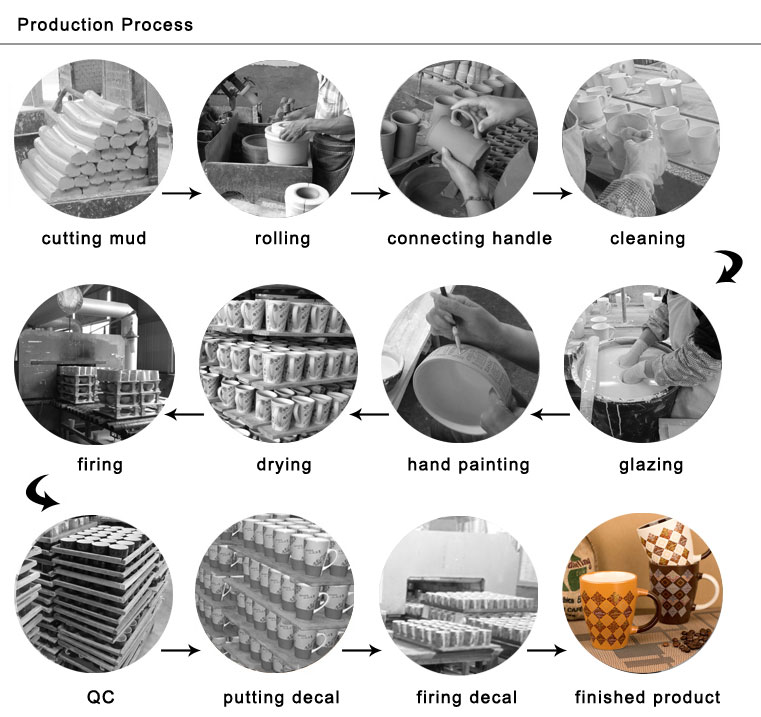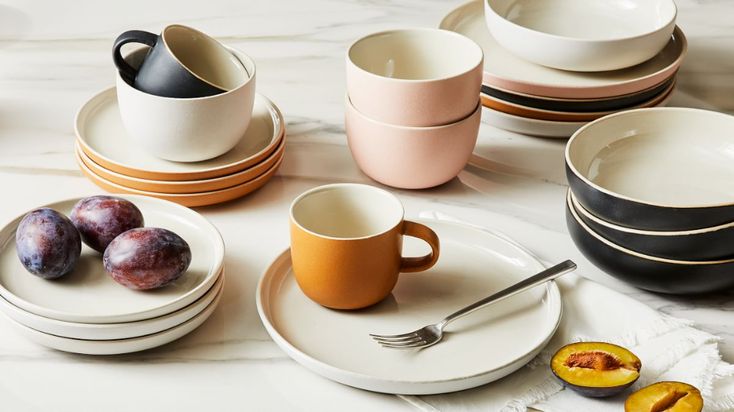
Keramikgeschirr ist in unserem täglichen Leben weit verbreitet, da es leicht zu reinigen ist, nach dem Einweichen nicht beschädigt wird und keine Flecken bekommt, weshalb es bei den Menschen sehr beliebt ist. Keramikgeschirr ist aufgrund seines eleganten Aussehens und seiner Langlebigkeit seit jeher ein beliebtes Geschirr auf dem Esstisch. Gleichzeitig sind Mikrowellenherde in der schnelllebigen modernen Zeit zu einem unverzichtbaren Gerät in vielen Familienküchen geworden. Während man die Annehmlichkeiten des Mikrowellenofens genießt, wird oft die Frage gestellt: Wie sicher ist Keramikgeschirr in der Mikrowelle?
Die Erforschung der Sicherheit von Keramikgeschirr in Mikrowellenherden hat nicht nur mit der Bequemlichkeit und Sicherheit des täglichen Lebens zu tun, sondern berührt auch mehrere Ebenen wie Materialwissenschaft, Lebensmittelsicherheit und Verbrauchererziehung. Wenn wir dieses Wissen richtig verstehen und anwenden, können wir potenzielle Gefahren vermeiden. In diesem Blog, Jinhua Keramiken wird Ihnen die Antwort zeigen.
Übersicht über keramische Materialien
Keramik gilt als das beste Material im Bereich des Tafelgeschirrs. Die besten Keramiken sind bekannt für ihre Elastizität, Festigkeit, Transparenz und Durchlässigkeit. Es mag zerbrechlich aussehen und leicht zerbrechen, aber es ist tatsächlich fest. Da dieses Material, Kaolin, durch Erhitzen von Ton bei hohen Temperaturen, in der Regel über 2.372 Grad Fahrenheit, hergestellt wird, macht es das Geschirr so stark und haltbar wie Glas, was die Haltbarkeit des Keramikgeschirrs gewährleistet.
Keramik, ein von Menschenhand geschaffenes Material mit einer langen Geschichte, seiner Vielfalt und seinem ästhetischen Wert, nimmt in der menschlichen Zivilisation eine zentrale Stellung ein. Bevor wir über die Sicherheit von Keramikgeschirr in Mikrowellenherden sprechen, ist es notwendig, die grundlegende Definition des Materials und das Prinzip seiner Wechselwirkung mit Mikrowellen zu verstehen.
Definition von Keramik
Keramik ist eine Art fester Werkstoff, der aus anorganischen, nichtmetallischen Materialien besteht, die bei hohen Temperaturen geformt und gebrannt werden. Sie weisen in der Regel eine hohe Härte, Hochtemperaturbeständigkeit, Korrosionsbeständigkeit und andere Eigenschaften auf. Der Hauptbestandteil von Keramik ist Kaolin, das in China und in der Region Limoges in Frankreich heimisch ist. Es wird bei hohen Temperaturen gebrannt und hat eine feine Textur, hohe Transparenz und einen klaren Klang. Keramik gilt allgemein als qualitativ hochwertig und eignet sich für viele Zwecke, auch für Geschirr.
Herstellungsverfahren für keramisches Essgeschirr
Der Herstellungsprozess von Keramikgeschirr umfasst im Allgemeinen die Schritte Auswahl des Rohmaterials, Zerkleinern, Mischen, Formen, Trocknen, Glasieren und Brennen. Die verschiedenen Arten von Keramikgeschirr unterscheiden sich erheblich in der Auswahl des Rohmaterials, der Brenntemperatur und der verwendeten Glasur. Diese Unterschiede wirken sich direkt auf die physikalischen und chemischen Eigenschaften aus, wie z. B. Dichte, Härte, Temperaturbeständigkeit und Durchlässigkeit für Mikrowellen.

Die Wechselwirkung zwischen Keramikgeschirr und Mikrowellen
Um festzustellen, ob Keramik sicher in Mikrowellenöfen verwendet werden kann, müssen wir zunächst das Funktionsprinzip von Mikrowellenöfen und die Wechselwirkungseigenschaften von Keramik mit Mikrowellen verstehen, was für die Bewertung ihrer Sicherheit in Mikrowellenöfen entscheidend ist.
Grundkonzept der Mikrowelle
Als Mikrowelle bezeichnet man eine elektromagnetische Welle mit einer Frequenz zwischen 300 MHz und 300 GHz. Elektromagnetische Wellen in diesem Frequenzbereich haben eine besondere Durchschlagskraft und können viele nicht-metallische Materialien durchdringen, werden aber von wasserhaltigen Stoffen absorbiert. Mikrowellenherde nutzen dies, um Lebensmittel zu erhitzen.
Wie erhitzen Mikrowellen Lebensmittel?
Das Magnetron im Mikrowellenherd erzeugt Mikrowellen, die ein gleichmäßiges elektromagnetisches Feld im Ofenhohlraum bilden. Die Wassermoleküle in Lebensmitteln sind polare Moleküle, deren positive und negative Ladungszentren sich nicht überschneiden. Unter der Einwirkung des Mikrowellenfeldes drehen sich die Wassermoleküle schnell und stoßen miteinander zusammen, wobei die dabei erzeugte kinetische Energie in Wärmeenergie umgewandelt wird, wodurch die Lebensmittel erhitzt werden. Dieser Prozess beginnt im Inneren des Lebensmittels und breitet sich nach außen aus, wodurch eine schnelle und effiziente Erwärmung erreicht wird.
Absorption und Reflexion von Mikrowellen durch verschiedene Materialien
Unpolare Materialien wie Keramik, Glas und Kunststoffe können in der Regel Mikrowellen durchdringen, ohne erhitzt zu werden, während polare, wasserhaltige Stoffe Mikrowellenenergie und Wärme absorbieren. Metallische Materialien reflektieren Mikrowellen und können daher nicht in Mikrowellenherden verwendet werden. Behälter aus verschiedenen Materialien haben unterschiedliche Absorptions- und Durchdringungsfähigkeiten für Mikrowellen, was sich auf die Erhitzungseffizienz und die Sicherheit von Lebensmitteln auswirkt.

Sicherheitsanalyse von Keramikgeschirr in Mikrowellenherden
Sicheres Keramikgeschirr, das für die Mikrowelle geeignet ist, sollte die folgenden Bedingungen erfüllen:
- Keine Metallverzierungen oder -kanten: Metall reflektiert Mikrowellen, die Funken verursachen oder den Mikrowellenherd beschädigen können. Daher ist Keramikgeschirr ohne Metalldekoration sicherer.
- Gleichmäßige Materialverteilung: Gleichmäßiges Material sorgt für ein gleichmäßiges Eindringen der Mikrowellen und vermeidet lokale Überhitzung.
- Keine schädlichen Pigmente: Einige Pigmente können sich unter Mikrowelleneinwirkung zersetzen oder schädliche Substanzen freisetzen.
Wie kann man feststellen, ob Keramikgeschirr mikrowellensicher ist?
- Prüfen Sie das Etikett oder die Gebrauchsanweisung des Produkts: Die Hersteller kennzeichnen in der Regel, ob das Produkt für die Mikrowelle geeignet ist.
- Führen Sie eine einfache Testmethode ein: Stellen Sie eine Keramikschüssel und eine kleine Menge Wasser in den Mikrowellenherd und erhitzen Sie sie eine Minute lang. Wenn die Schale nur warm, aber nicht heiß ist, bedeutet dies, dass sie nicht viel Mikrowellenenergie absorbiert hat, was bedeutet, dass diese Keramikschale relativ sicher ist. Ist die Keramikschale hingegen sehr heiß, sollte sie nicht in den Mikrowellenherd gestellt werden. Führen Sie diesen Test sorgfältig durch und achten Sie auf die Einhaltung der Sicherheitsvorschriften, um Verbrennungen oder andere Unfälle zu vermeiden.

Vergleich von Keramik mit anderen Materialien
Vergleich von Keramik mit herkömmlichen Mikrowellenöfen wie Glas und Kunststoff:
- Glas: Hitzebeständiges Glas (z. B. Borosilikatglas) ist in Mikrowellenherden eine sehr sichere Option. Es absorbiert weder Mikrowellen noch gibt es schädliche Stoffe ab. Es hat eine hohe Transparenz und es ist leicht, den Zustand der Lebensmittel zu beobachten. Im Vergleich zu Keramik kann Glas jedoch bei plötzlichen Temperaturschwankungen leichter brechen.
- Kunststoffe: Nicht alle Kunststoffe sind für die Verwendung in Mikrowellenherden geeignet. Achten Sie auf Kunststoffbehälter mit der Aufschrift "mikrowellensicher" oder ähnlichen Symbolen auf dem Boden. Diese Kunststoffe sind hitzebeständig und lassen sich nicht so leicht verformen, können aber bei längerem Gebrauch oder hohen Temperaturen Spuren von Chemikalien freisetzen, so dass sie mit Vorsicht ausgewählt werden müssen.
Zusammenfassung der Vor- und Nachteile der einzelnen Materialien
- Keramik: Schön und haltbar, aber Sie müssen auf die Sicherheitsprobleme achten, die durch Metalldekorationen und unebene Materialien verursacht werden können.
- Glas: Sicher und transparent, leicht zu beobachten, aber empfindlich gegenüber Temperaturschwankungen und bruchgefährdet.
- Kunststoffe: Leicht und praktisch, aber man muss auf die Mikrowellensicherheit achten, damit keine Chemikalien freigesetzt werden.
Schlussfolgerung
Die Entwicklung von Keramikgeschirr hat einen langen Prozess durchlaufen, und eine große Vielfalt an buntem Porzellangeschirr kann die verschiedenen Bedürfnisse der Menschen erfüllen. Keramik ist im Allgemeinen als Mikrowellengeschirr sicher, vor allem, wenn es die Normen für metallfreie Verzierungen und gleichmäßige Materialverteilung erfüllt. Entscheidend ist, dass man sie richtig auswählt und verwendet und Designs und Materialien vermeidet, die das Eindringen in die Mikrowelle beeinträchtigen oder ein Sicherheitsrisiko darstellen könnten.
Mit den Fortschritten in der Materialwissenschaft werden ständig neue Keramiken und andere mikrowellenfreundliche Materialien entwickelt, die weitere Vorteile in Bezug auf Sicherheit, Haltbarkeit und Umweltschutz bieten können. Daher ist es für Verbraucher und Hersteller gleichermaßen wichtig, die neuen Entwicklungen in der Keramikindustrie im Auge zu behalten und die neuesten Sicherheitsstandards und Empfehlungen zu kennen. Die Hersteller müssen diese Informationen kennen, um sicherzustellen, dass sie stets die sichersten und am besten geeigneten Keramikgeschirrprodukte herstellen können.
Jinhua Keramiken ist bestrebt, das verbraucherfreundlichste Keramikgeschirr herzustellen, wobei wir stets auf die Trends der Branche und die neuesten Technologien achten und unseren Partnern das wettbewerbsfähigste und preisgünstigste Großhandels-Keramikgeschirr anbieten. Klicken Sie hier zur Ansicht unserer Großhandel für Keramikgeschirr Serie. Wir glauben, dass Keramikgeschirr in Zukunft effizienter und praktischer für den täglichen Gebrauch sein wird. Wir freuen uns, wenn Sie uns für weitere Informationen kontaktieren!


